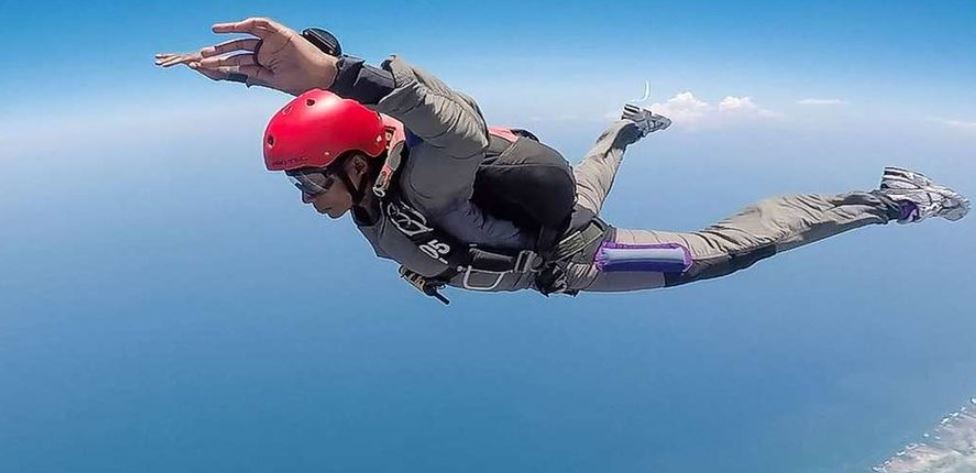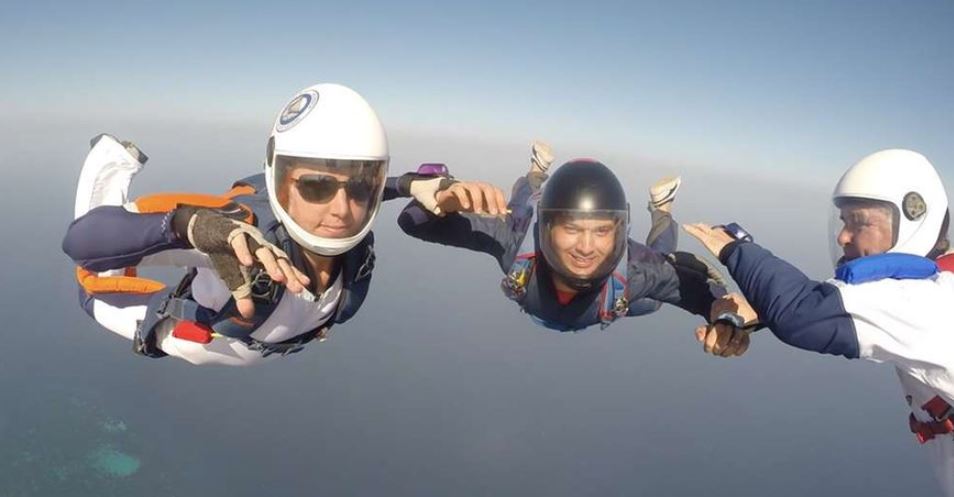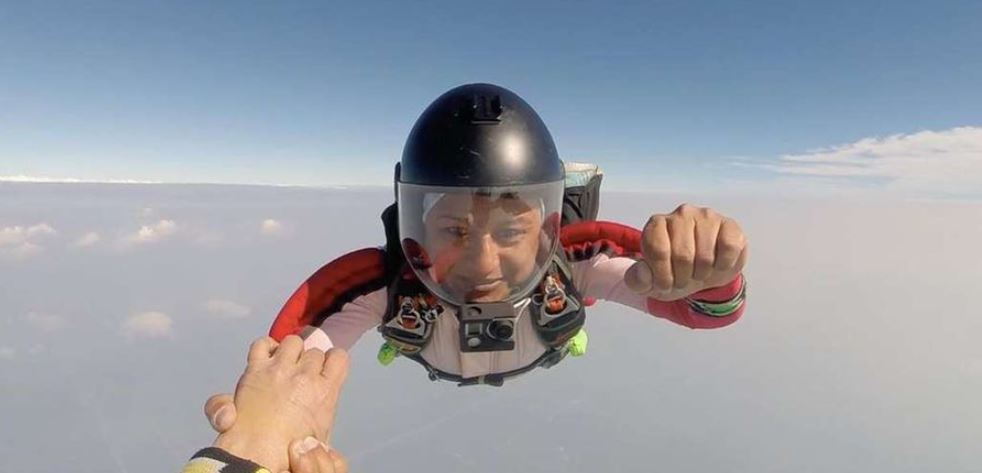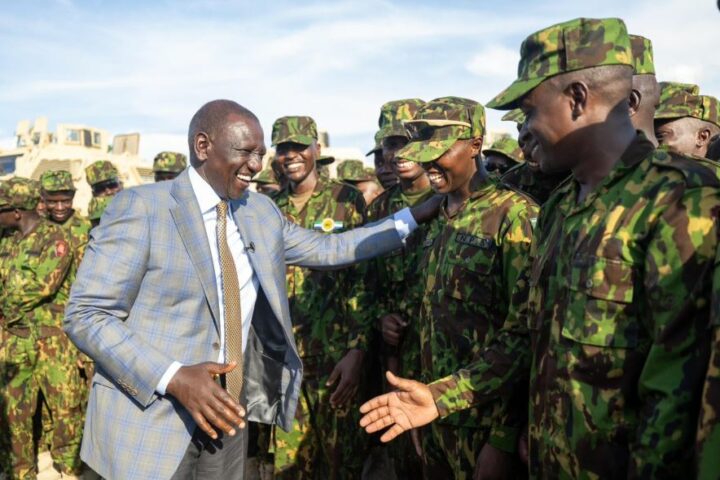Three thrill-seeking Kenyan women who are into solo skydiving share their experiences.
Anne-Marie Burugu, 47
Co-founder of Vivo Activewear

It was definitely, without a doubt, the most challenging (not to mention risky), nerve-racking yet exhilarating and liberating thing I had ever done.
My first jump was in November 2017. It was a tandem jump organised in honour of one of my closest friends who was turning 50 and had created a “50 things I’d love to do by the time I turn 50” list.
Skydiving was on her list and had been on my bucket list. So, together with a few friends, we decided to gift her that experience and while at it, I was going to check it off my list.
I was terrified and was trying very hard not to show my fear. At the point when we landed, I felt a mixture of pure exhilaration and joy. It also happens very quickly.
That December, I enrolled for the Accelerated Freefall (AFF) training and licence to be able to do solo jumps and so the next jump was on my own.
I was an extremely slow learner because of my insane fear of heights. There is a time I would get to the plane door, look down and just freeze. I am always so grateful to the instructors at Skydive Diani for their incredible patience and commitment to helping me become a skilled and safe skydiver. The fantastic ground crew, too, played a massive role in helping to keep me alive.
My last jump was on December 1, 2018. That was my 37th jump. I had been trying to advance onto getting my B licence, which is earned and issued at 50 jumps.
Skydiving has immensely deepened my spirituality and faith in God, and provided such strong parallels for the challenges I have in life — such as the importance of facing my fears, learning to embrace them, and most importantly, learning to relax in the face of fear, never giving up!
It taught me what it means to truly surrender and how “small” we are in this world.
No two jumps were ever the same, and every jump taught me something new about myself and revealed a part of me I never knew.
Through skydiving, I experienced some wonderful highs, but also very many low and scary moments, not to mention some very close calls. During my last jump In December 2018, I had a very bad landing. I broke my arm.
Initially, my motivation was a mixture of fun and the will to conquer my fears. I also had a dream to work my way up to 500 jumps and hopefully become a tandem instructor, helping to give others that amazing first taste of the skydiving experience.
Having not jumped in a while, plus life has taken over, that dream of being an instructor got shelved though I am planning to skydive for leisure starting next year.
Valéry Weyn, 31
Architect at Valéry Weyn Architects

I couldn’t believe my dad was flying through the sky and landing on the beach with such ease. Later on, my older brother learned to skydive. He was the youngest person I ever saw skydiving and suddenly it occurred to me that it was within my reach.
My first jump went by pretty quickly. I was filled with equal parts of excitement and butterflies for what was about to happen. I did my final checks on my gear when the plane levelled out and the pilot gave the signal. The experienced jumpers got out first.
We moved towards the open door of the airplane at 11,000 feet above sea level, nothing but the sky and the horizon in front of me. For a split second, I stood still. Then my instructors gave me the nod, and we tumbled forward into the blue. It happened so fast. I saw flashes of blue everywhere: First deep blue then light blue.
We did a somersault exiting the aircraft. I didn’t know which way was up at first as bits of sky and ocean spiralled in front of me. I felt weightless. Just before my mind could make sense of if it all, we stabilised and I could see both my instructors beside me giving me hand signals.
Just like that, a switch flipped on and my body went into autopilot mode. There was no time to be overwhelmed. Every second counted. I carried out the exercises I had been trained to do, the ones I recited in my head over and over the last few days, and finally, at 5,000 feet I pulled the ripcord to deploy my parachute.
Only this time, it was not like how we practised all the times before during ground school. The ’chute deployed and I felt the full force of gravity on my body and then absolute bliss as I looked up and savoured the view. Under the canopy, I could feel the warm ocean breeze. It’s like I fell through an invisible barrier and the heat suddenly hit me.
My instructor landed on the beach earlier than me and tried to guide me safely to the landing zone using the radio fixed inside my helmet. I couldn’t hear a thing he said. I was literally on cloud nine at this point. Luckily for me, I had some flying lessons before I did my first skydive.
The landing pattern for flying and skydiving is very similar, and I felt very comfortable in my environment despite it being my first solo jump and canopy ride. My piloting skills proved to be on point as I landed safely on the beach at the designated drop zone. I couldn’t wait for the next jump. I don’t think of it as a risk. It’s an experience; a passion.
Chances of getting hurt are the same as any other sport. With good training, practice, and discipline in the sport, there is no reason any jumper should get hurt. Good judgement plays a big role. I misjudged the direction of the winds once in my early days. I landed downwind and had a bit of a tumble on the beach. No injuries, though. Just another lesson I learnt that day.
Skydiving is unlike any other sport I’ve done and there are two parts to it: The teamwork and skills involved in formation skydiving during freefall and the sheer joy of the canopy ride afterward. Every time I jump I just want to get better and better.
It has taught me to handle situations logically and calmly. There is no need to panic, even in tricky situations. Just evaluate your surroundings and plan a course of action. No time to dilly-dally.
Every time I hear a plane fly overhead and the skies are clear, I have the urge to skydive. I don’t look at the sky the same way I used to. I see a cloud and remember what it was like the first time I fell through one. Every time I board a flight, I think about jumping out.
Zainab Alibhai, 43
Skydiving instructor

At the moment, I am in Dubai skydiving and getting some tunnel time too. I have jumped more than 700 times in Kenya, United Arab Emirates, South Africa, Germany, Italy, and the US.
My first jump was in Diani on March 8, 2014. A friend persuaded me to take the leap of faith and start living in the now. It has been one of the best decisions of my life. I made up my mind as soon as we landed that this was my sport, and two weeks later I signed up for training to do my first solo jump.
I still remember the feeling of a great accomplishment. I could not stop smiling. I am at “home” skydiving. I believe it’s because of the freedom I feel during the free fall and the peace of mind it gives me during the entire experience.
When I’m at the door and the green light is on and I jump off the aeroplane, my mind changes. I get into a state of mind that nothing is important besides that moment — the present. To be 100 per cent in the present is priceless. The fear, my life questions, the anxiety of a project, the responsibilities and stress of everyday life, and anything else that can disturb my mind is gone.
I don’t remember a single time I landed my parachute and wasn’t smiling. I’m always stoked after a jump. It’s a very personal feeling. You need to try to understand. Every jump is nerve-racking, it’s not more like a stomach drop, it’s not like a roller coaster drop because you are looking at the horizon and seeing the world with different lens.
I have become independent, stronger, and found happiness within myself. The desire to skydive every day, improve the way I fly, and pass on this knowledge and experience to a fellow skydiver is the most satisfying feeling.
To become a skydiver, we go through a programme called AFF (Accelerated Freefall Program), which consists of Categories A through H with AFF instructors and coaches. And to jump with a fellow skydiver, one has to achieve an A licence after completing 25 jumps.
Skydiving, like anything else, requires a desire to learn something new and an investment of your time (and money).
So, how easy is it to learn to skydive? If you’re interested in learning how to skydive, lean in, and begin with a tandem skydive. It is an excellent introduction that teaches you some essential tips that will help you realise your skydiving dreams.
It is an extreme sport; accidents may happen, and every skydiver is responsible for their jump and safety. Thankfully, I have had no such incidents yet. It is worth every risk and penny. I cannot describe to you the feeling till you have fallen from the sky yourself.
My dream is to open a drop zone in Kenya and be able to teach and make tandem skydiving possible for Kenyans and tourists.
Source: Lifestyle






